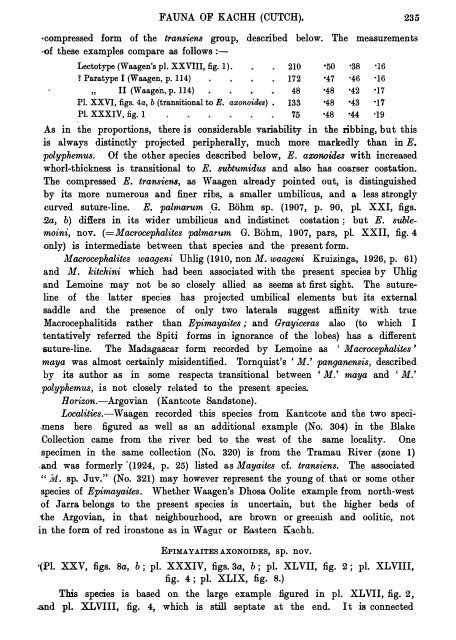ialontolngia ndita,
ialontolngia ndita,
ialontolngia ndita,
You also want an ePaper? Increase the reach of your titles
YUMPU automatically turns print PDFs into web optimized ePapers that Google loves.
FAUNA OF KACHH (CUTCH). 235<br />
·compressed form of the transiens group, described below. The measurements<br />
-of these examples compare as follows :-<br />
Lectotype (Waagen's pi. XXVIII, fig. 1).<br />
1 Paratype I (Waagen, p. ll4)<br />
, II (Waagen, p. ll4)<br />
PI. XXVI, figs. 4a, b (transitional to E. axonoides) •<br />
PI. XXXIV, fig. I<br />
210<br />
172<br />
48<br />
133<br />
75<br />
•<br />
50<br />
•47<br />
•48<br />
•48<br />
•48<br />
•38 •16<br />
•46 •16<br />
•42 • 17<br />
•43 •17<br />
•44 •19<br />
As in the proportions, there is considerable variability in the ribbing, but this<br />
is always distinctly projected peripherally, much more markedly than in E.<br />
polyphemus. Of the other species described below, E. axonoides with increased<br />
whorl-thickness is transitional to E. stibtumidus and also has coarser costation.<br />
The compressed E. transiens, as Waagen already pointed out, is distinguished<br />
by its more numerous and finer ribs, a smaller umbilicus, and a less strongly<br />
curved suture-line. E. palmarum G. Bohm sp. (1907, p. 90, pi. XXI, figs.<br />
2a, b) differs in its wider umbilicus and indistinct costation ; but E. stiblemoini,<br />
nov. (=Macrocephalites palman.tm G. Bohm, 1907, pars, pl. XXII, fig. 4<br />
only) is intermediate between that species and the present form.<br />
Macrocephalites waageni Uhlig (1910, non M. waageni Kruizinga, 1926, p. 61)<br />
and M. kitchini which<br />
had been associated with the present species by Uhlig<br />
and Lemoine may not be so closely allied as seems at first sight.<br />
The sutureline<br />
of the latter species has projected umbilical elements but its external<br />
saddle and the presence of only two laterals suggest affinity with true<br />
Macrocephalitids rather than Epimayaites ; and Grayiceras also (to which I<br />
tentatively referred the Spiti<br />
forms in ignorance of the lobes) has a different<br />
·suture-line. The Madagascar form recorded by Lemoine as ' Macrocephalites '<br />
maya was almost certainly misidentifi.ed.<br />
Tornquist's 'M.' panganensis, described<br />
by its author as in some respects transitional between 'M.' maya and 'M.'<br />
polyphemus, is not closely related to the present species.<br />
Horizon.-.Argovian (Kantcote Sandstone) .<br />
Localities.-Waagen recorded this species from Kantcote and the two speci<br />
.mens here figured as well as an additional example (No. 304) in the Blake<br />
Collection came from the river bed to the west of the same locality. One<br />
specimen in the same collection (No. 320) is from the Tramau River (zone 1)<br />
.and was formerly · (1924, p. 25) listed as Mayaites cf. transiens. The associated<br />
"Xvl . sp. Juv." (No. 321) may however represent the young of that or some other<br />
species of Epimayaites. Whether Waagen's Dhosa Oolite example from north-west<br />
of J arra belongs to the present species is uncertain, but the higher beds of<br />
the Argovian, in that neighbourhood, are brown or greenish and oolitic, not<br />
in the form of red ironstone as in Wagur or Eastern Kachh.<br />
EPIMAYAITES AXONOIDES, sp. nov.<br />
•(Pl. XXV, figs. Sa, b; pi. XXXIV, figs. 3a, b; pl. XLVII, fig. 2; pl. XLVIII,<br />
fig. 4; pl. XLIX, fig. 8.)<br />
This species is based on the large example figured in pl. XLVII, fig. 2,<br />
.and pl. XLVIII, fig. 4, which is still septate at the end. It is connected
















